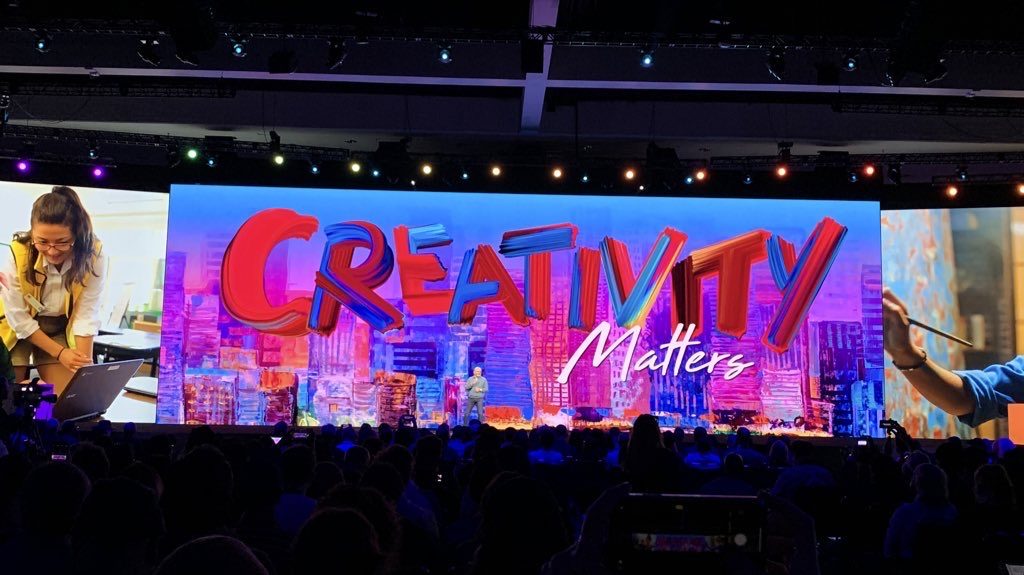Last week I had an opportunity to attend Adobe MAX as an Adobe Insider. In this blog post, I want to share some big ideas from the event as well as actionable takeaways for educators. Although MAX is definitely the creativity conference, the focus on creativity in education was front and center through multiple events during this week.
You might have followed along on Instagram as I shared pictures from this year’s Adobe MAX. I had a chance to “meet” Elmo and Grover and hear inspiring stories from creative professionals. I’ve pulled together some highlights from the event, and I’m excited to share with you today!
Research on Creativity in Education
To kick-off events at Adobe MAX, I spent the afternoon at Educator Day. This event was designed for educators attending MAX as well as local educators interested in creativity in education. During the Educator Day, I had a chance to learn about new research from Adobe.
Their new report is titled, “Get Hired: The Importance of Creativity and Soft Skills.” You can download the full report from the Campus Adobe homepage. It shares how creativity is seen as a need in the workplace and how students in Generation Z view these skills. As part of this work, they reviewed millions of job postings and resumes. The team also conducted interviews with professionals in the field to create the report.
Although you’ll find lots of interesting information in the report, one big thing that jumped out for me was their review of the skills most often found in job postings. It provides some insight into the type of skills currently sought after by companies posting job offerings. It includes:
- Communication
- Creativity
- Collaboration
- Creative Problem Solving
- Critical Thinking
Collaboration in the Classroom
In my book, Tasks Before Apps: Designing Rigorous Learning in a Tech-Rich Classroom, I have an entire chapter on collaboration in the classroom. Here’s an excerpt:
Students need to understand how to collaborate using digital tools— to problem-solve and exchange feedback with partners as they consume, create, and interact with content. Although there are times when placing a device in the hands of each student is the right choice for a lesson, other times you’ll want students to share devices so that they can practice their collaboration skills. Collaboration is an essential component of effective teaching and learning that translates to everyday experiences and innovations.
pg. 59
You can see the full study from Adobe on their Camp Adobe landing page. I definitely encourage you to download the document. If you are designing programming for students, reviewing curriculum goals, or making a case for more “soft skills” in the classroom, it’s a must-have.
Using Adobe Spark with students this year? Download these free graphic organizers!
3D Design from Limbitless
Another highlight from Educator Day was a presentation from the team at Limbitless Solutions. You’ve probably seen videos or heard stories of student 3D printing projects that have had an impact on their school or community. From addressing everyday problems to making significant changes in the lives of people around the world, 3D printing is a powerful vehicle for creative problem-solving.
The team at Limitless Solutions shared how they have used 3D design to transform the lives of thousands of children. In the video above, Bill Gates visited their center at the University of Central Florida. Their story demonstrates the power of creative thinking. It also shows how educators can make cross-curricular connections, and help students design with a purpose. If you’re exploring audiences for student design creations or looking for inspiration for problem-based learning projects, I encourage you to check them out.
Creativity in Education
At MAX this year, director M. Night Shyamalan shared his journey as a creative professional on the main stage of the event. He talked about the way he persevered when facing challenges early in his career and what it’s like to work outside of the Hollywood bubble.
In addition to his session on the main stage of MAX, M. Night Shyamalan also spoke about his work in education. A few years ago, he released a book titled, I Got Schooled: The Unlikely Story of How a Moonlighting Movie Maker Learned the Five Keys to Closing America’s Education Gap. I haven’t read his book yet, but the paperback version is sitting in my Amazon cart. I’m hoping to dive into it during some downtime this winter.

Another book I’m looking forward to checking out is From Cradle to Stage: Stories from the Mothers Who Rocked and Raised Rock Stars. Dave Grohl, the singer, songwriter, and drummer of Nirvana and Foo Fighters, shared this title during his conversation on the main stage of MAX. His mother is a retired public school teacher who spends time touring with her rockstar son. She wrote this book after interviewing other mothers of well-known musicians. Not only do I love the teacher-connection, but you might use this type of narrative writing format as a mentor text for students, too!
Spark in Education
This year at MAX, Ben Forta and I celebrated the book birthday of 40 Ways to Inject Creativity into Your Classroom with Adobe Spark. On the final day of the event, I joined Veronica Belmont from the Spark team to share some ways to use Spark in Education. In the video below, you can see the replay of the live event along with the discussion that took place.
Are you using Adobe Spark with students this year? Download these free graphic organizers or check out this new blog post with more classroom ideas.
If you’re looking for some creative inspiration this school year, check out the research on creativity from Adobe. It’s free to download and full of information to take into consideration as you plan to make the most of the second half of the school year.







